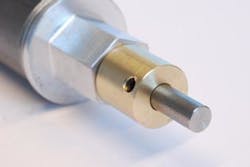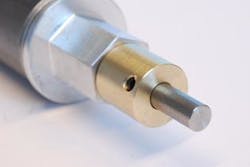Clamping for laser fixtures
Harderwijk, Netherlands – In a laser welding fixture, all welding seams should be clamped with a zero gap. To accomplish this, a hydraulic pusher is often used. Although this solution works well, the fact that it is hydraulic is a disadvantage in a laser welding fixture. Oil spills and the risk of fire due to sparks emitted during the welding process are always present.
AWL has developed an alternative solution – a pneumatic pusher that has a maximum pressure of 16 bar, achieving a pressure force of 785, which is sufficient for pressing sheet metal parts in laser welding applications within the automotive market.
The pneumatic pusher has the same outer size as the hydraulic one, but a larger piston diameter can be applied, which increases the surface and the pressure force. With a load of 16 bar, a special system with a compressor or booster is required.
The AWL-developed cylinder is specifically intended for applications where there is little space, but a need for many pressure points. This solution offers good perspective for welding thin plates in the automotive industry.
To ensure that parts of a product within a given tolerance are well clamped, AWL developed a variant with a magnetic piston. In cases where pressure points need to be even closer than the 30mm that is normal with a pneumatic pusher, an attachment can be placed with a U-shaped fork anti-twist feature, enabling clamping even closer together.
The pneumatic pushers will be the new AWL standard and will replace the hydraulic pushers from now on. Customers have already shown interest to replace their existing hydraulic fixtures with the AWL pneumatic principle.
Benefits are:
- No hydraulics are used in the fixture, so no risk of oil leakage/fire.
- No need for a hydraulic power unit
- Cost effective
- Possibility to eject products from the fixture via the extra release stroke
- Possibility of position detection by using a magnetic piston
- Quick and easy to replace because the cylinders are placed individually and not in a manifold like the hydraulic cylinders
- Existing hydraulic pushers are easy to replace with pneumatic ones.
For more information send an email to: [email protected]

